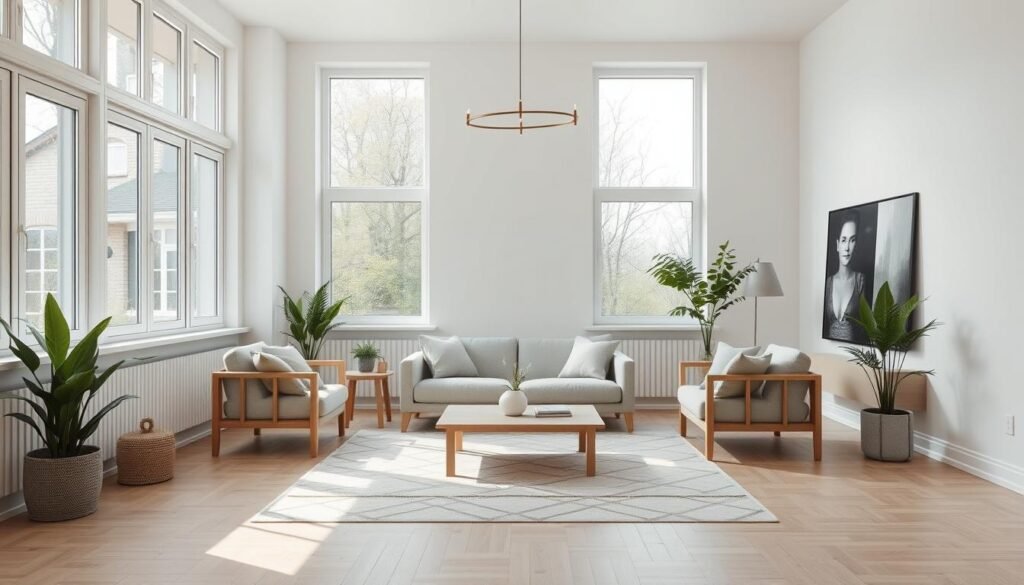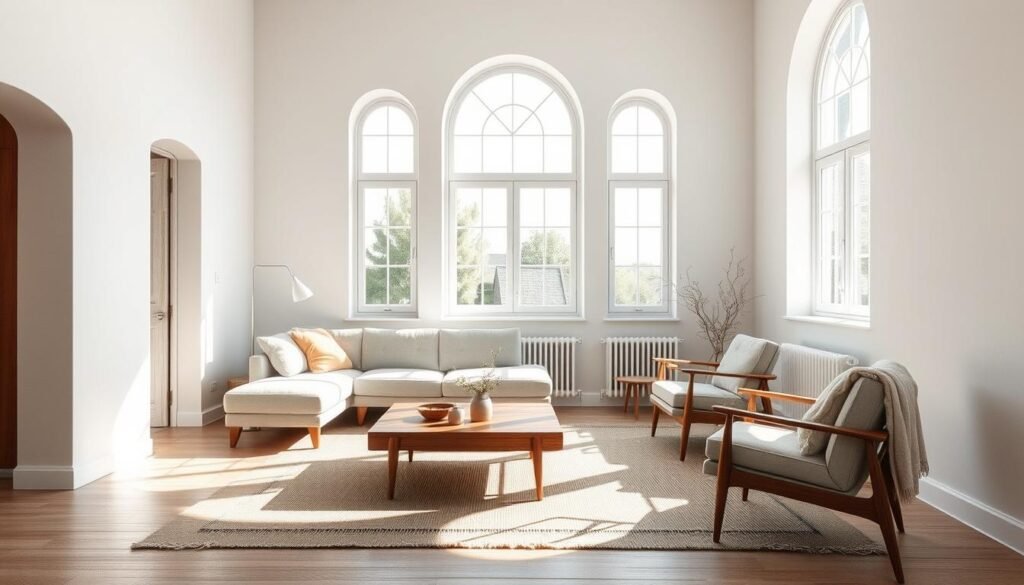This post may contain affiliate links. When you purchase through links on our site, we may earn an affiliate commission.
Creating a living space that balances beauty and responsibility changed how I view my home. What started as a fascination with clean-lined interiors evolved into a meaningful practice of choosing materials and layouts that respect our planet. This philosophy isn’t about sacrificing style—it’s about crafting environments that nurture both people and ecosystems.
Through years of experimenting, I’ve learned that intentional choices create lasting impact. Natural wood finishes, energy-efficient lighting solutions, and multifunctional furniture became my toolkit for spaces that feel airy yet grounded. The magic happens when simplicity meets purpose, proving that mindful decisions can elevate daily life.
My journey taught me that quality always beats quantity. Investing in durable pieces from ethical sources reduces waste without compromising aesthetics. This approach helps maintain clutter-free zones that promote mental clarity, while renewable resources like wool and linen add warmth to minimalist foundations.
Key Takeaways
- Blend functionality with eco-friendly materials for spaces that age gracefully
- Prioritize natural light and multifunctional layouts to maximize energy efficiency
- Choose durable, ethically sourced furnishings over disposable decor trends
- Incorporate renewable textiles and low-VOC finishes for healthier interiors
- Create visual calm through purposeful editing and strategic storage solutions
Introduction to Sustainable Scandinavian Design
My home transformation began with a realization about waste. Years ago, I filled rooms with short-lived decor that lost its charm faster than I could recycle the packaging. That cycle changed when I discovered a philosophy rooted in thoughtful simplicity.
https://www.youtube.com/watch?v=qa8E0O0lwSQ&pp=ygUKI2h5Z2dlcm9vbQ%3D%3D
My Personal Journey Toward Eco-Friendly Living
I once believed redecorating meant chasing trends. Shelves overflowed with impulse buys that ended up donated or discarded. A pivotal moment came when I calculated my annual decor waste—enough to fill a dumpster. That’s when I embraced principles valuing purpose over excess.
Switching to multifunctional furniture saved space and reduced my consumption. Instead of synthetic accents, I chose organic cotton throws and reclaimed wood tables. Each piece now serves daily needs while reflecting my values.
Why This Style Resonates With Sustainability
Three core ideas make this approach work:
- Less but better: Investing in durable items means fewer replacements
- Natural materials: Responsibly sourced wood and textiles biodegrade safely
- Timeless aesthetics: Neutral palettes outlast passing fads
This connection to nature transformed how I view interiors. Rooms breathe easier without clutter, and every item tells a story of mindful choices. It’s not just about looking good—it’s about creating spaces that honor our planet.
Understanding Scandinavian Design Principles
At its core, this approach blends practicality with quiet elegance. Every element works harder—not louder—to create rooms that feel both inviting and intentional. Through trial and error, I’ve discovered how foundational ideas shape spaces that age like fine wine.

Minimalism and Clean Lines
Early in my journey, I learned to treat empty space as a design feature. My living room once had seven decorative items on a single shelf. Now, three meaningful pieces create breathing room. Simple geometric shapes in furniture and architecture guide the eye without overwhelming it.
I swapped busy patterns for solid textiles in muted tones. This shift made my bedroom feel larger, even though the square footage stayed the same. Editing becomes an art form—each item must justify its presence through daily use or emotional value.
Functionality and Quality Craftsmanship
My favorite armchair proves multi-tasking magic. Its curved oak frame supports posture during work hours, while the wool upholstery stays cozy through winter movie nights. Built-in storage under window seats hides seasonal linens without bulky cabinets.
Three lessons transformed how I evaluate furnishings:
- Joinery matters more than finishes—dovetail drawers outlast glued ones
- Natural materials adapt better to temperature changes
- Neutral foundations let bold accents shine when desired
Investing in a handcrafted dining table taught me patience. Its imperfections tell stories, while mass-produced alternatives chip within months. Now, I seek makers who sign their work—proof of pride in every detail.
Exploring Eco-Friendly Materials and Natural Light
What truly transformed my space wasn’t just choosing better materials—it was learning how they interact with daylight. This combination creates rooms that feel alive while keeping environmental impact low.

Embracing Renewable Materials: Wood, Bamboo, and Organic Textiles
Responsibly harvested wood became my anchor. My dining table’s oak surface warms the room visually and physically. Bamboo shelves surprised me with their strength—they’ve held cookbooks for years without warping.
For soft furnishings, I mix linen curtains with wool throws. These textiles age beautifully, developing character instead of showing wear. Unlike synthetics, they don’t release microplastics during washes.
Maximizing Natural Light in Your Home
I learned to treat sunlight like furniture. Positioning mirrors opposite windows doubled the light in my hallway. Sheer roller shades filter glare without blocking views.
White walls act as reflectors, while matte finishes prevent harsh glare. This approach cut my lamp usage by 40% in daytime hours. The best part? Morning coffee tastes better bathed in sunrise hues.
Combining these elements creates harmony. Wood grains shift under moving shadows, and linen weaves glow at golden hour. My home now feels connected to outdoor rhythms—a quiet reminder of nature’s intelligence.
Implementing sustainable scandinavian design tips
Transforming rooms into efficient, earth-conscious zones starts with strategy. I begin every project by mapping out existing items and their potential. That vintage dresser? It became a bathroom vanity with fresh paint and reclaimed hardware. This method saves money while keeping usable pieces from landfills.
Building Your Action Plan
My guide focuses on gradual upgrades. First, research companies using recycled metals or FSC-certified wood. Next, replace worn-out items with these better options. Last month, I swapped plastic kitchenware for bamboo alternatives—small changes with big impact.
Local makers became my secret weapon. A ceramicist near Austin crafts lamps from river clay, cutting shipping emissions. These unique finds add character while supporting community artisans.
Smart Savings Strategies
Thrift stores offer hidden gems. I found solid oak chairs for $25 each—sanded and reupholstered with organic fabric. Online marketplaces provide gently used rugs and lighting at 70% off retail.
Repair kits extend furniture life. Wood filler fixed my coffee table’s scratch, while fabric patches revived favorite cushions. When buying new, I save for heirloom-quality items that outlast trends.
This approach creates rooms that evolve with your needs. Start with one corner, then let your successes fuel the next project. Remember—progress beats perfection every time.
Embracing Minimalism and Intentional Consumption
Adopting minimalism transformed how I interact with my space. Instead of chasing temporary trends, I now focus on what truly adds value. This shift reduced stress and environmental impact while creating rooms that feel genuinely mine.

Quality Over Quantity: Investing in Timeless Pieces
My living room sofa taught me the power of patience. After waiting six months, I found a certified hardwood frame with organic cotton upholstery. Three years later, it still looks new despite daily use by my family and pets.
Three principles guide my purchases now:
- Check production methods: Local artisans get priority
- Demand multi-functionality: Storage ottomans replace side tables
- Verify material origins: FSC-certified wood tags matter
Mindful Purchasing and Waste Reduction
I created a 48-hour rule for non-essential items. If I still want it after two days, I research its environmental footprint. This simple habit cut my impulse buys by 80% last year.
| Impulse Purchase | Intentional Choice | Impact Difference |
|---|---|---|
| Decide in 5 minutes | Research for 2+ days | 73% less buyer’s remorse |
| Plastic decor | Reclaimed wood art | 12x longer lifespan |
| Trendy colors | Neutral foundations | 7-year style relevance |
Clutter-free surfaces became my productivity hack. With fewer items to manage, I gain two extra hours weekly—time spent enjoying my space rather than organizing it.
Selecting Eco-Friendly Furniture and Decor
Choosing home furnishings became an ethical journey when I discovered their environmental impact. Every bookshelf and accent chair now tells a story of resource stewardship and thoughtful creation. This shift led me to makers who share my values—those transforming materials into heirlooms rather than landfill fodder.
Sourcing Sustainable and FSC-Certified Items
I always start with labels. The FSC certification mark guarantees my wood comes from forests where trees regrow faster than they’re harvested. My favorite coffee table proves this—its oak surface originated from a managed grove in Oregon that plants three saplings for every tree cut.
Recycled materials surprised me with their versatility. A local workshop crafts stools from repurposed steel drums, their industrial charm contrasting beautifully with organic textiles. These items avoid resource extraction while showcasing innovative reuse.
Long-Term Benefits of High-Quality Craftsmanship
My grandmother’s walnut cabinet taught me about endurance. Its dovetail joints, cut by hand in 1948, still hold firm today. Modern craftsmanship achieves similar longevity through techniques like mortise-and-tenon joinery and kiln-dried hardwoods.
| Feature | Budget Option | Quality Choice |
|---|---|---|
| Material Source | Composite wood | FSC-certified oak |
| Construction | Stapled joints | Dovetail joinery |
| Lifespan | 2-5 years | 25+ years |
| Environmental Impact | 3 landfill trips | Zero waste |
Investing in skilled designers pays dividends. My custom dining set has survived seven holiday dinners and two moves unscathed. Its solid ash construction resists dents better than cheaper alternatives, proving that quality materials outperform trends every time.
By supporting ethical creators, I’ve built a home that ages like fine wine. Each scratch adds character rather than signaling impending replacement. This approach turns everyday furniture into legacy pieces—functional art that outlives disposable decor.
Utilizing Natural Textiles and Accents
Textures became my secret weapon for adding depth to rooms. I discovered how organic textiles could soften minimalist spaces while keeping them grounded in nature. This approach transformed stark areas into welcoming retreats without clutter.
Breathable Fibers for Healthier Homes
Organic cotton changed my bedding game. Unlike conventional options, it breathes better during Texas summers. I use it for pillowcases that stay cool against skin—no chemical residues from pesticides.
Linen curtains taught me patience. They wrinkle beautifully, adding character to windows. Their loose weave filters light while insulating against drafts. Bonus? They need washing half as often as synthetics.
Wool rugs anchor my living room. They trap heat in winter yet feel cool underfoot during heatwaves. When spills happen, the natural lanolin resists stains better than plastic fibers. These materials work with seasons, not against them.
Mixing textures creates visual interest. I layer wool throws over linen sofas, adding cotton cushions in earthy colors. This combo feels cohesive because each natural material shares an organic origin story. Rooms now whisper comfort through every thread.

 using WordPress and
using WordPress and 
No responses yet